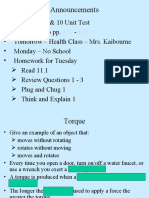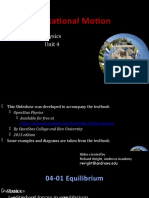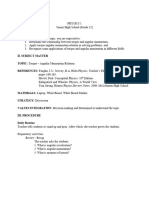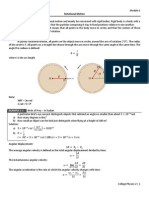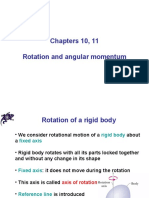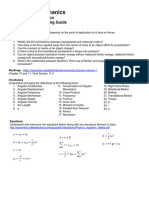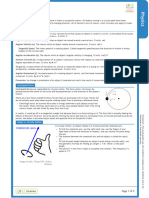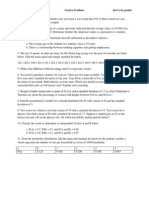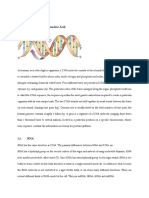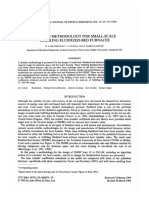ATá2 0
Minds¥On Physics
Activity
Solving Rotational
Dynamics Problems
Purpose and Expected Outcome
In this activity, you will learn more about rotational dynamics, which involves the forces
exerted on rotating systems and the response of those systems (i.e., angular
acceleration). You will learn how to apply the concepts of torque and moment of inertia
to problem situations involving rotating systems.
Prior Experience / Knowledge Needed
You should know dynamics. You should know NewtonÕs laws and how to apply them to
physical situations. You should have some experience analyzing and solving problems
in dynamics, and you should know how to apply empirical force laws. In addition, you
should have some experience with rotational kinematics, and you should be able to
recognize when a system is accelerating. You should know the definitions of torque, net
torque, and moment of inertia relative to a fixed axis.
NEWTONÕS 2ND LAW IN ROTATIONAL FORM
NewtonÕs 2nd law (Fnet = m a) is valid and applicable for all objects and systems.
However, when a rigid body is spinning about a fixed axis, it is more convenient to use
angular quantities, such as angular velocity and angular acceleration, to describe its
motion. (At any particular instant, every part of the rigid body has a different velocity
but the same angular velocity.) In terms of angular acceleration, NewtonÕs 2nd law is
written:
τnet,p = Ip αp NewtonÕs 2nd law for rotations about a fixed axis
where τnet,p is the net torque on the rigid body about a fixed axis through point p, Ip is
the objectÕs moment of inertia for rotations about the same axis, and αp is its angular
acceleration. Note that τnet,p and αp are vectors.
MINDS¥ON PHYSICS /
Advanced Topics in Mechanics 79
© 2000 Kendall/Hunt Publishing Company
� Explanation of Activity
Solve each of the problems described below. If necessary, translate the problem to a
linear dynamics problem, and think about how you would solve it.
A1. A 10g hanger is placed on a device as shown. The pegs are evenly spaced and labeled 1
through 13. Hangers of various masses are available.
1 2 3 4 5 6 7 8 9 10 11 12 13
10g
?
(a) What mass will balance the 10g hanger when placed on peg #1? Explain why it
balances.
(b) Where should you put a 15g hanger to balance the 10g hanger? (The unknown
hanger is removed.)
(c) Where should you put a 3g and a 4g hanger (at the same time) to balance the 10g
hanger?
(d) Is it possible to balance the arrangement with only the 10g hanger (and nothing
else)? If so, how? If not, explain why not.
(e) How many ways are there to arrange a 2g, a 3g, and a 5g hanger so that each is on
its own peg, and the arrangement is balanced? Describe at least two arrangements.
(The 10g hanger is removed.)
A2. A string is wound around a metal wheel that is free to 20cm
spin on a frictionless pivot. A hanging mass is connected
to the other end of the string. The wheel is given a twist,
causing it to start rotating at 21/2 rad/s in the
counterclockwise direction. All known quantities are
shown in the figure.
(a) What is the initial velocity of the hanging mass? M = 1.2kg
(b) Estimate the angular acceleration of the disk. Icenter = 60kgácm2
(c) Approximately when does the disk stop? Explain.
(d) Estimate the velocity of the mass at t = 2s. m = 10g
(e) Estimate the acceleration of the mass at t = 3s.
continued
Activity ATá20
80 Solving Rotational Dynamics Problems
�A3. A bicycle is supported off the ground using a clamp (shown in the scale drawing)
attached to the post. The wheel weighs
about 50N, and a force of 15N is applied clamp
to the pedal.
(a) Estimate the moment of inertia of
the wheel.
(b) Estimate the net torque applied to
the front gear, the tension in the
chain, and the net torque applied
to the back gear.
(c) Estimate the angular acceleration
10cm
of the wheel.
A4. Two masses are attached to strings wound around a double 20cm
pulley as shown. The double pulley has a total mass of 1200g 10cm
(1.2kg), and the total moment of inertia about its center is
50,000gácm2 (0.005kgám2).
(a) If the arrangement is released from rest, which direction
will it start to rotate? Explain.
(b) Estimate the angular acceleration of the double pulley.
(c) Which mass is traveling faster at any instant, or are they
traveling with the same speed? Explain. If their speeds 300g 500g
are different, what is the ratio of their speeds?
(d) Estimate the velocity of the 300g mass at t = 2s.
A5. The hard disk on your computer is Òspinning
ω
angular velocity (rad/s)
upÓ according to the graph at right when a 200¹
malfunction occurs, and the hard disk slows
down again. 150¹
(a) If the net torque exerted on the hard
100¹
disk initially is about 0.08Nám, estimate
the hard diskÕs moment of inertia.
50¹
(b) What is the net torque exerted on the
hard disk after the malfunction? 0 t
0 1 2 3 4 5
(c) What is the net torque exerted on the
hard disk at t = 5s? Explain. time (s)
MINDS¥ON PHYSICS /
Advanced Topics in Mechanics 81
� Reflection
R1. What do you find most difficult about solving problems in rotational dynamics?
R2. For any of the situations or problems, did you think about what the linear motion
situation or problem might look like? Why or why not?
R3. (a) What is the general relationship between the angular
displacement Æθ of a spinning wheel and the displacement M, Ic
Æy of a mass hanging from a string wound around the
wheel? Explain. In your relationship, what are the units R
of the angular displacement? Why?
(b) What is the general relationship between the angular
velocity ω of the wheel and the velocity vy of the hanging
mass? Explain.
(c) What is the general relationship between the angular m
acceleration α of the wheel and the acceleration ay of the
hanging mass? Explain.
R4. Reconsider situation A2, in which a hanging mass is attached to a string wound around a
solid wheel.
(a) When the arrangement is free to spin, which is larger, the tension in the string or
the weight of the hanging mass? Explain your reasoning.
(b) Did you ignore this difference when you solved problem A2? Did you know that you
had ignored this difference?
(c) How does this affect your answers? (If you do not ignore this difference, which
answers become slightly larger, which ones stay the same, and which ones become
slightly smaller?)
R5. Reconsider situation A3, in which a bicycle is held off the ground with a clamp.
(a) What features did you ignore to answer the questions?
(b) How would your answers change if you did not ignore these features? (If you did not
ignore these features, which answers would be larger, which would stay the same,
and which would be smaller?)
R6. Is it possible to exert a force at the edge of an object without exerting a torque about its
center? Give an example of a situation involving a bicycle wheel in which a force is
exerted to the rim of the wheel, but no torque is exerted about the center of the wheel.
Activity ATá20
82 Solving Rotational Dynamics Problems


